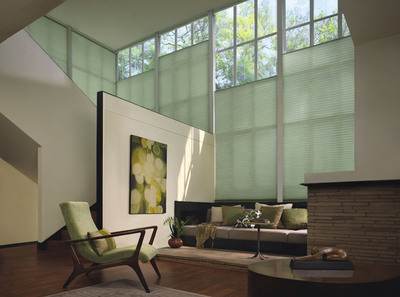- MENU
- HOME
- SEARCH
- WORLD
- MAIN
- AFRICA
- ASIA
- BALKANS
- EUROPE
- LATIN AMERICA
- MIDDLE EAST
- United Kingdom
- United States
- Argentina
- Australia
- Austria
- Benelux
- Brazil
- Canada
- China
- France
- Germany
- Greece
- Hungary
- India
- Indonesia
- Ireland
- Israel
- Italy
- Japan
- Korea
- Mexico
- New Zealand
- Pakistan
- Philippines
- Poland
- Russia
- South Africa
- Spain
- Taiwan
- Turkey
- USA
- BUSINESS
- WEALTH
- STOCKS
- TECH
- HEALTH
- LIFESTYLE
- ENTERTAINMENT
- SPORTS
- RSS
- iHaveNet.com: Home & Garden
Rita St. Clair

Expansive windows featured in modern houses can present interior design challenges. In this landmark Richard Neutra house in Los Angeles, Hunter Douglas "Duette" honeycomb shades are used to solve the problems of privacy and light control
Some interior designers speak of styles as though they're entirely distinct and thus incompatible with one another. I don't share that purist position, however. I've found that familiarity with particular styles can allow two or more to be successfully blended in a single room. Adaptation and imagination are the key factors in blurring differences and creating an attractive eclectic setting.
The house we recently bought was built in the 1950s. The Realtor describes it as modern in design, though I don't understand how a 50-something house qualifies as modern. The living room has a big glass wall that's presenting us with treatment issues. Can you help us figure out how to achieve privacy and light control while not interfering with a great view? Furniture suggestions would also be welcome.
Your confusion about terminology is widely shared. "Modern," as an architectural and interior design term, refers specifically to more angular and ornamented style than previous ones that developed in Europe in the 1920s and '30s and gradually made its way across the Atlantic. "Modern" isn't the same as "contemporary," which is how designers describe a more minimalist look that is often a more pared down style of traditional designs as well as modern that's been popular for the past decade or two.
Plenty of books have been written about modern architecture and design. You should acquaint yourself with its motifs, proportions and materials. In the meantime, I offer this photo that illustrates some common characteristics of modernism and that shows a setting perhaps similar to your own. Floor-to-ceiling windows, an absence of embellishments and strong geometric forms are all hallmarks of this style.
But this is no ordinary modern interior. It's part of a landmarked house in Los Angeles designed by Richard Neutra (1892-1970), one of the giants of modern architecture. "Duette" honeycomb shades from Hunter Douglas are used here to solve the problems of privacy and light control and to ensure that the exterior remains on view at the pull of a cord. The individual shades can be raised and lowered from the top or bottom.
I bet the original owners would have been delighted with this stylistically modern treatment. These days, they would also appreciate the efficient heating and cooling that the shades make possible. It's a type of treatment worth considering for your own home. As for the furniture, purists will argue that all the pieces must be consistent in their styling with the modern architecture.
Some other designers, myself among them, will say that only certain elements -- storage units, seating and tables -- have to have a modernist look in order to reinforce the architecture. A combination of modern pieces and antiques could work well as accessories in this setting, as could colorful rugs of other periods and styles. To each his own but, I'd want to add softness and some visual pizzazz to a setting like the one seen here. It's too stern and sterile for my taste.
Availble at Amazon.com:
Ranches: Design Ideas for Renovating, Remodeling, and Building New (Updating Classic America)
AUTOS | HOBBIES | EDUCATION | FAMILY | FASHION | FOOD & RECIPES | HOME DECOR | RELATIONSHIPS | PARENTING | PETS | TRAVEL | WOMEN
What to Do With a Wall of Windows - Window Shades
Article: Copyright © Tribune Media Services